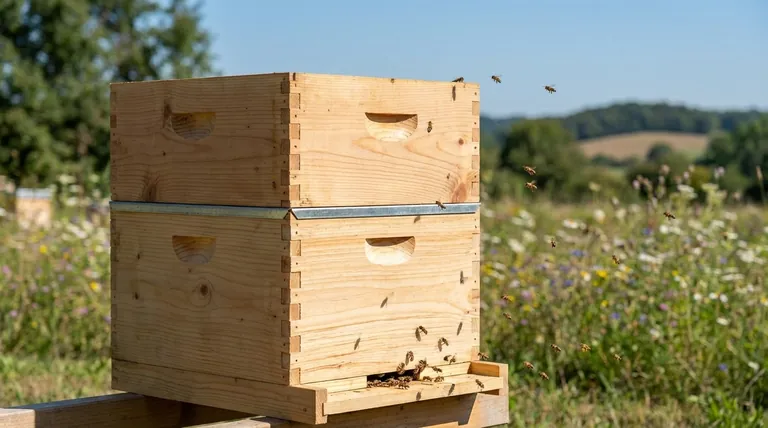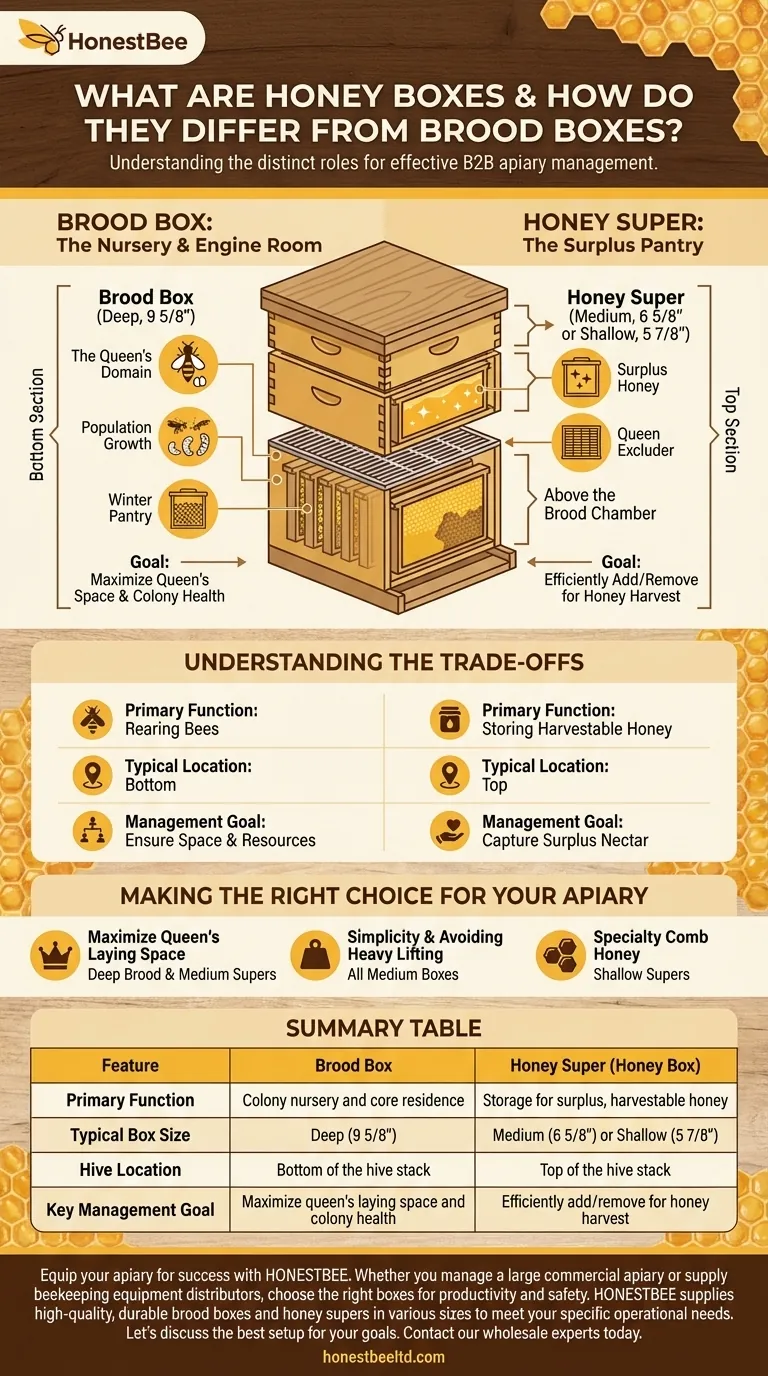At its core, a brood box is the nursery and engine room of the beehive, while a honey box, often called a "super," is the pantry designed for storing surplus honey. The fundamental difference lies in their designated purpose within the hive, which in turn dictates the size beekeepers typically use for each.
While the boxes themselves can be physically interchangeable, their roles are distinct. The brood box is managed for colony health and population growth, whereas the honey super is managed for an efficient and manageable honey harvest.

The Brood Box: The Heart of the Colony
The brood box, or hive body, forms the foundational core of the hive. It is the permanent, year-round residence for the honeybee colony.
The Queen's Domain
This is where the queen bee lives and lays her eggs. The frames inside the brood box are filled with "brood" in all its stages—eggs, larvae, and pupae—as well as the pollen and honey required to feed them.
Designed for Population Growth
Beekeepers typically use deep boxes (9 5/8 inches tall) for the brood chamber. This larger size provides the queen with ample, uninterrupted space to lay eggs in a solid pattern, which is crucial for building a large, robust workforce of bees.
The Colony's Winter Pantry
The brood box also contains the essential food stores the bees rely on to survive the winter. A healthy hive will have a perimeter of honey and pollen frames surrounding the central brood-rearing area.
The Honey Super: The Surplus Pantry
A "super" is any box placed above the brood chamber. Its name comes from its position, being "super" (Latin for above) the main hive body. Its sole function is to hold surplus honey.
A Focus on Practicality
Honey supers are typically medium (6 5/8 inches) or shallow (5 7/8 inches) boxes. The reason for this is purely practical: weight. A deep box filled with honey can weigh over 80 pounds, making it extremely difficult and dangerous to lift.
Built for the Harvest
Because these boxes are intended for honey that will be harvested, beekeepers often place a queen excluder between the brood box and the honey supers. This grate is large enough for worker bees to pass through but too small for the queen, ensuring she cannot lay eggs in the frames meant for honey collection.
Understanding the Trade-offs
The choice between box types is a strategic decision based on function, management style, and physical capability.
Primary Function
The brood box is for rearing bees. The honey super is for storing harvestable honey. This is the most critical distinction.
Typical Location
Brood boxes form the bottom section of the hive stack. Honey supers are added to the top as the colony grows and the nectar flow begins.
Management Goal
The goal with the brood box is to ensure the queen has space and the colony has resources to thrive. The goal with honey supers is to add and remove them in line with the season to capture surplus nectar.
Making the Right Choice for Your Apiary
Your beekeeping goals and physical limitations should guide your equipment choices.
- If your primary focus is maximizing the queen's laying space: Use the traditional setup of one or two deep brood boxes with medium or shallow honey supers on top.
- If your primary focus is simplicity and avoiding heavy lifting: Consider standardizing your entire hive with all medium-sized boxes for both brood and honey, allowing for interchangeable frames and lighter loads.
- If your primary focus is producing specialty comb honey: Use shallow supers, as their smaller frame size is ideal for creating perfect sections of comb.
Understanding the distinct roles of these two components is the first step toward effective and sustainable hive management.
Summary Table:
| Feature | Brood Box | Honey Super (Honey Box) |
|---|---|---|
| Primary Function | Colony nursery and core residence | Storage for surplus, harvestable honey |
| Typical Box Size | Deep (9 5/8") | Medium (6 5/8") or Shallow (5 7/8") |
| Hive Location | Bottom of the hive stack | Top of the hive stack |
| Key Management Goal | Maximize queen's laying space and colony health | Efficiently add/remove for honey harvest |
Equip your apiary for success with HONESTBEE.
Whether you manage a large commercial apiary or supply beekeeping equipment distributors, choosing the right boxes is fundamental to productivity and safety. HONESTBEE supplies high-quality, durable brood boxes and honey supers in various sizes to meet your specific operational needs, from maximizing honey yield to simplifying hive management.
Let's discuss the best setup for your goals. Contact our wholesale experts today to get the right equipment for a thriving and efficient operation.
Visual Guide

Related Products
- Langstroth Honey Bee Box Hive Boxes for Different Depths
- Professional 500g Sectional Comb Honey Frame System for Beekeeping
- Inverted Squeezable Honey Jar with No Drip Flip Top Cap for Easy Pouring
- Portable Bee Mating Hive Boxes Mini Mating Nucs 8 Frames for Queen Rearing
- Economy Small Scale Honey Dryer Dehumidifier Thickening Machine
People Also Ask
- What is the purpose of the boxes in a Langstroth hive? A Guide to Modular Beekeeping Success
- What are the sizes available for Langstroth boxes? A Guide to 8-Frame vs. 10-Frame & Depths
- Why do you need two bee hives? Boost Your Apiary's Success with Smart Risk Management
- How deep is a medium bee box? Unlock the Key to a Versatile and Manageable Hive
- How should hive boxes be aligned after reassembly? Ensure a Perfect Seal for Hive Health



















